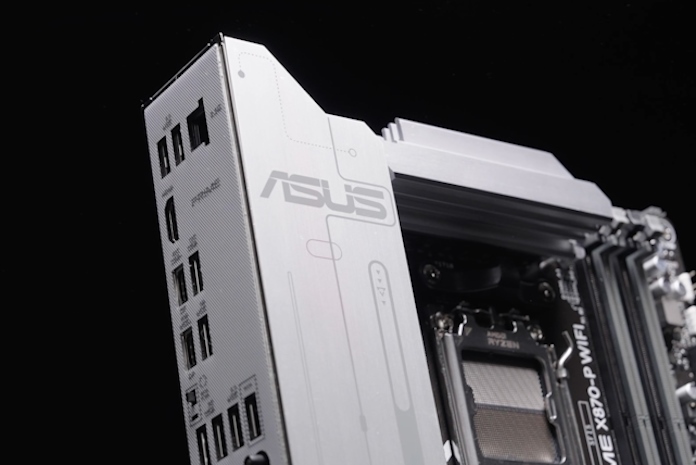Now that exploring PC hardware is part of my professional life, I sometimes forget where my PC journey started. Back when I was a kid, my older brother and I would build PCs in the garage just for the fun of it. I won’t claim that there was anything all that special about the computers we pieced together from used parts scavenged from the classified section of the newspaper, but we loved every step of the process. (Yes, I just dated myself with that last sentence.)
Every so often, something new will come out in the PC hardware space that rekindles that sense of excitement in me. Right now, it’s the latest AMD Ryzen 9000 Series processors and their accompanying X870E/X870 motherboards that are taking me back in time to those hours building PCs in the garage and getting me excited to start from scratch with a new build. Here’s everything that I’m eager to experience for myself with this new hardware.
DDR5, now even better
I might have to turn in my nerd card for saying this, but optimizing memory settings was never my favorite part of building a new PC. Like many enthusiasts out there, I applauded the arrival of memory profiles like EXPO. When it comes to setting up my memory, I’ve happily been taking the easy way out ever since.
New memory features with the X870E/X870 platform might get me back and tinkering, though. I’m happy to see JEDEC support for DDR5-5600 right out of the box — that means that my memory kit will run faster, even when I’m using baseline settings. Support for on-the-fly memory overclocking is a nice bonus, too. The ability to adjust my memory speeds and timings in real-time using the Ryzen Master application would make it so much easier to optimize my settings. What’s more, I’ll be able to use the new Memory Optimized Performance Profile (MOPP) to automatically switch between JEDEC and EXPO profiles depending on the type of application that I have running.

AMD isn’t the only one debuting new memory features. I’m also excited about NitroPath DRAM Technology, appearing exclusively in the ROG Crosshair X870E Hero and ROG Strix X870E-E Gaming WiFi motherboards. This revolutionary DRAM slot design reduces noise interference via shorter gold finger pins and optimized signal pathways within the motherboard. That better equips me to push the overclocking limits of my DDR5 RAM while enjoying enhanced system stability.
Between higher baseline speeds, support for real-time memory overclocking, and a new DRAM slot design, ASUS and AMD have accomplished something that I once thought was impossible: they’ve gotten me excited to tinker with memory settings again.
A robust platform for a custom AI PC
Like many PC enthusiasts, I’ve been eagerly seeking out opportunities to take advantage of new AI-powered apps and features. As a gamer, I’ve already seen first-hand what technologies like Ray Reconstruction and DLSS can do to make my games look stunningly realistic — and run at supremely fluid frame rates, too. As an amateur photographer, I use Photoshop’s AI-powered tools just about every time I edit a photo. I’m more than ready to see what AI can do to turbocharge my productivity, video editing, and music recording, too.
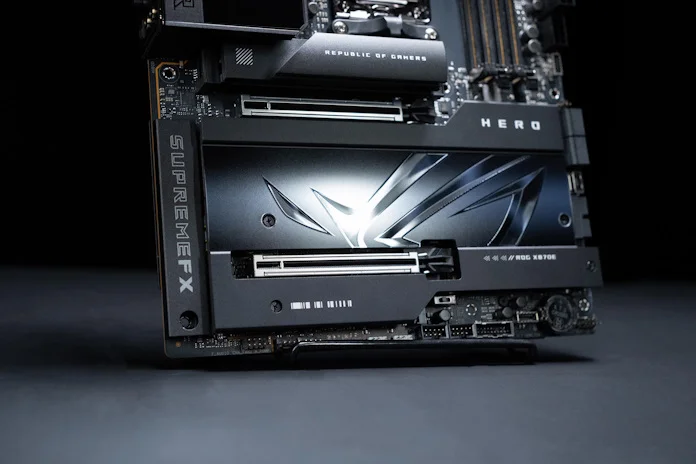
To get the most out of AI, I need an AI PC. ASUS X870E motherboards and the new AMD Ryzen 9000 Series CPUs were purpose-built for the era of the AI PC. The high-end ROG Crosshair X870E Hero and ProArt X870E-Creator WiFi motherboards offer dual PCIe 5.0 x16 slots so that I can harness not just one, but two graphics cards to accelerate my AI workloads. These boards offer the high-end cooling options that I need to keep my components comfortable during sustained workloads. And smart, one-click technologies like AI Overclocking, AI Cooling II, and AI Networking II stand ready to streamline my complete experience.
Time for a wireless networking upgrade
The arrival of WiFi 7 is easily one of the most important events in the world of tech in 2024. Like most folks out there, my house is full of connected devices all competing for bandwidth. Since my wife and I both work primarily from home, we can’t afford to let the winners and losers of our wireless network be determined by the whim of a last-gen router.
Our whole-home WiFi 7 upgrade is going to solve so many problems for us. The raw gen-over-gen speed boost offered by WiFi 7 speaks for itself, but there’s so much more. WiFi 6E introduced the 6GHz band, but WiFi 7 will let me do more with it thanks to ultra-wide 320MHz channels and MLO. The new ASUS WiFi 7 routers also give me easy network segmentation options. I’m eager to put all my kids’ devices onto their own network so that I can automatically cut off their internet access at bedtime.
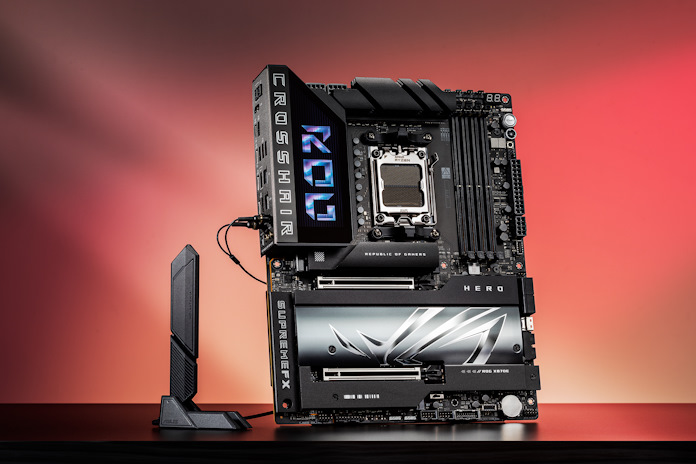
To take full advantage of my new WiFi 7 router, I also need WiFi 7 devices. And that’s where the new lineup of X870E and X870 motherboards comes in. With the sole exception of the ASUS Prime X870-P, a motherboard with no onboard WiFi module, every ASUS X870E and X870 motherboard supports WiFi 7. Whether I grab the top-of-the-line ROG Crosshair X870E Hero or a more-mainstream TUF Gaming X870-Plus WiFi, I’ll get access to the next generation of wireless networking.
BIOS, updated
Throughout all the changes that I’ve seen in my years of building PCs, there’s one element of the process that has largely stayed the same: the BIOS. While plenty of new features have been added over the years, its design, interface, and basic functionality looks a lot like how it did when I first started building PCs. And that’s okay. I like my reliable, functional, tried-and-true BIOS.
But as much of stuck-in-the-past curmudgeon as I am, even I’m intrigued by updates coming for the ASUS BIOS with our X870E and X870 motherboards. First off, BIOS is getting a resolution bump up to 1920×1080. With this change, I’ll be able to see more content at a glance, making it easier to survey the available settings and find the ones that I need.
Second, the new BIOS Q-Dashboard helps bridge the gap between the settings in BIOS and the physical layout of my new motherboard. It gives me a perspective view of my exact motherboard model right inside of BIOS with the vital components and connections neatly labeled.
I can easily see the new BIOS Q-Dashboard playing a key role in familiarizing me with a new motherboard, and the resolution increase will undoubtedly streamline my experience whenever I need to adjust a setting. When it comes to the BIOS, I’m not interested in change for change’s sake, but once I start working with these updates I’ll probably wonder how I ever got by without them.
An easy PC DIY experience
As an old hand in the world of PC building, it stands out to me just how easy it is anymore. With every new generation of parts, the process of assembling a PC gets smoother and more streamlined — and there are so many more resources available for novice builders today than when I first got started.
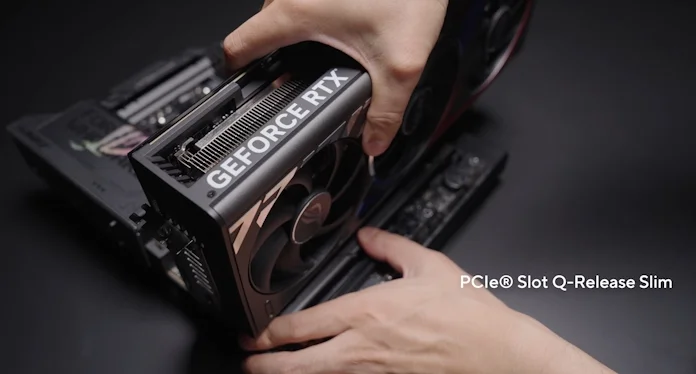
Out of all the new PC DIY-friendly updates coming with X870E and X870 motherboards, I’m especially intrigued by the PCIe Slot Q-release Slim. By default, PCIe x16 slots have a little plastic latch that releases any add-in card that you’ve installed. But that latch can be a little hard to reach when you’ve installed a graphics card with a beefy backplate and thick, powerful cooler.
Our PCIe Slot Q-Release Slim neatly takes care of this problem. With this mechanism, I don’t need to release a latch or even push a button. To remove a graphics card, I start by pressing on the motherboard with one hand to prevent it from moving while I detach the graphics card. I grip the graphics card at the left side (close to its I/O bracket). Then, I slightly tilt the card while pulling upward, and my graphics card will release from the PCIe slot. Easy peasy.
Sophisticated good looks, supreme performance
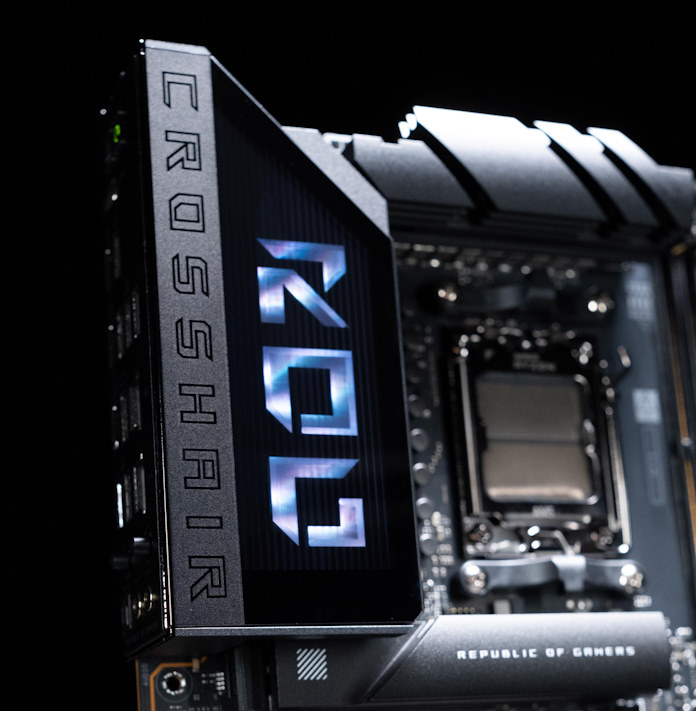
My earliest custom-built PCs were all beige boxes. (Thanks, 1990’s design aesthetic.) When PC chassis design took off in the 2000s, so did my imagination. I’ve built hulking full-tower PCs, compact space-saving machines, gaming rigs decked out with glorious synchronized RGB LED lighting effects, eye-catching white-themed PCs, and more.
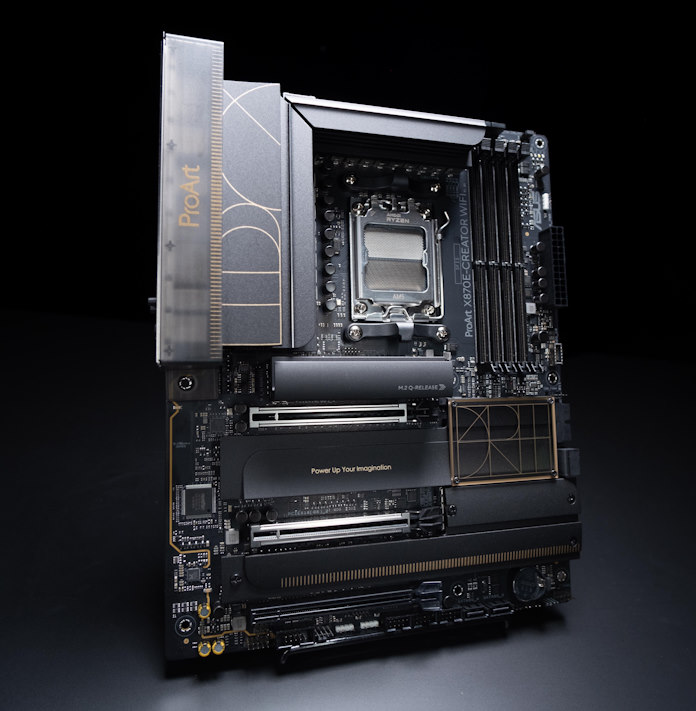
These days, my tastes run toward minimalist designs that allow form to follow function. That’s why I love the ProArt ecoysystem of PC components. They’re built to handle the performance demands of professional creators, and they’re draped in a professional aesthetic that never feels out of place. With its black-and-gold colorway, parallel lines, and understated adornments, the ProArt X870E-Creator WiFi would look sharp in the ProArt PA602 chassis. I was already sold by this board’s two onboard USB4 ports, dual Ethernet ports, robust cooling, and WiFi 7 support, but its upscale design seals the deal for me.
Meet the full ASUS X870E / X870 motherboard lineup

With everything new that’s coming out with AMD Ryzen 9000 Series CPUs and the ASUS X870E / X870 motherboard lineup, I can’t wait to roll up my sleeves and start building. If you’re as intrigued as I am by the performance potential and features of these new components, head over to our full X870E / X870 motherboard guide to meet all our new options.

